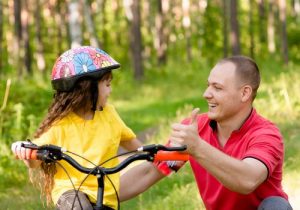Teaching Children How to Ride a Bike

You don’t have to be a professional cyclist to show your children how to ride a bike. All you need to do is make sure you’re prepared and have the time and desire to teach them. With these factors, the two of you will surely figure it out in no time.
The ideal time for children to start riding a bike will mainly depend on the development of their motor skills. Generally, it can be done when children are three years old. That’s when they have the skills to maintain their balance and pedal.
There are children who can do it at an earlier age, just as there are others who may take a little longer. The important thing is that your child wants to learn and you can motivate him.
It’s also ideal for children to learn to ride a bike before they’re six years old. After that, they begin to realize their fears and it may be more difficult for them to be brave.
Teaching children how to ride a bike
First, we’ll list the requirements:
- Safety gear: helmet, and knee and elbow pads. These protect children from injury when they fall.
- A child’s bicycle suitable to the child’s height.
- A spacious place free of obstacles and people in which your child has the freedom to pedal.

What makes this process go smoothly?
1. The right size bike
The size of the bike should match children’s height. They should be able to reach the ground with flat feet while sitting on the seat. This provides them with greater security, which will facilitate the learning process.
2. A good brake system
Another very important factor is the brake system. These should be easy to use so that your child can use them at any time and without any problem.
In general, children tend to lower their feet to brake, but the best thing to do is to show your child how the brakes work and how to use them correctly.
3. Prior knowledge
If your child had a tricycle prior to learning how to ride a bike, the process may be easier. You can remove one or both training wheels so that the children learn to balance on the bike.
Let them sit and gain confidence by raising and lowering their feet several times when they feel the bike going sideways. You can also make it go forward with momentum while they raise their feet and hold their balance.
“The ideal time for children to start riding a bike depends mainly on their motor skill development.”
4. Give clear instructions
Explain how to pedal. First, children tend to pedal backwards several times, as this is easier. Let them do it a few times, but explain how to pedal forward. After they do this, they’ll see that the bike moves.

5. Provide unconditional support
Now that your child knows how to pedal, hold the back of the seat so that the bike stays upright and tell him to leave one foot on the ground and the other on the pedal. The foot remaining on the pedal will depend on whether your child is right-handed or left-handed. The foot on the pedal exerts the starting force.
Help your child with a little momentum by pushing on the seat, and tell him to raise the other foot the moment the bike starts moving in order to begin pedaling. After the child does this, let go of the seat and let him pedal without stopping.
The work is almost done. You just have to encourage him to keep trying.
Remember that children may fall from the bike several times during this process. This is normal, so both you and the child need to control your nerves.
After all, the safety equipment you’ve provided will protect the most important parts of the body, such as the child’s head.
If children see that you’re nervous, it’s harder for them to trust themselves. Encourage them!
You don’t have to be a professional cyclist to show your children how to ride a bike. All you need to do is make sure you’re prepared and have the time and desire to teach them. With these factors, the two of you will surely figure it out in no time.
The ideal time for children to start riding a bike will mainly depend on the development of their motor skills. Generally, it can be done when children are three years old. That’s when they have the skills to maintain their balance and pedal.
There are children who can do it at an earlier age, just as there are others who may take a little longer. The important thing is that your child wants to learn and you can motivate him.
It’s also ideal for children to learn to ride a bike before they’re six years old. After that, they begin to realize their fears and it may be more difficult for them to be brave.
Teaching children how to ride a bike
First, we’ll list the requirements:
- Safety gear: helmet, and knee and elbow pads. These protect children from injury when they fall.
- A child’s bicycle suitable to the child’s height.
- A spacious place free of obstacles and people in which your child has the freedom to pedal.

What makes this process go smoothly?
1. The right size bike
The size of the bike should match children’s height. They should be able to reach the ground with flat feet while sitting on the seat. This provides them with greater security, which will facilitate the learning process.
2. A good brake system
Another very important factor is the brake system. These should be easy to use so that your child can use them at any time and without any problem.
In general, children tend to lower their feet to brake, but the best thing to do is to show your child how the brakes work and how to use them correctly.
3. Prior knowledge
If your child had a tricycle prior to learning how to ride a bike, the process may be easier. You can remove one or both training wheels so that the children learn to balance on the bike.
Let them sit and gain confidence by raising and lowering their feet several times when they feel the bike going sideways. You can also make it go forward with momentum while they raise their feet and hold their balance.
“The ideal time for children to start riding a bike depends mainly on their motor skill development.”
4. Give clear instructions
Explain how to pedal. First, children tend to pedal backwards several times, as this is easier. Let them do it a few times, but explain how to pedal forward. After they do this, they’ll see that the bike moves.

5. Provide unconditional support
Now that your child knows how to pedal, hold the back of the seat so that the bike stays upright and tell him to leave one foot on the ground and the other on the pedal. The foot remaining on the pedal will depend on whether your child is right-handed or left-handed. The foot on the pedal exerts the starting force.
Help your child with a little momentum by pushing on the seat, and tell him to raise the other foot the moment the bike starts moving in order to begin pedaling. After the child does this, let go of the seat and let him pedal without stopping.
The work is almost done. You just have to encourage him to keep trying.
Remember that children may fall from the bike several times during this process. This is normal, so both you and the child need to control your nerves.
After all, the safety equipment you’ve provided will protect the most important parts of the body, such as the child’s head.
If children see that you’re nervous, it’s harder for them to trust themselves. Encourage them!
All cited sources were thoroughly reviewed by our team to ensure their quality, reliability, currency, and validity. The bibliography of this article was considered reliable and of academic or scientific accuracy.
- Toapanta, D. O. N., & Herrera, E. R. Y. (2020). Motivación y uso de la bicicleta en niños de 10 a 12 años en Tena. Lecturas: Educación Física y Deportes, 25(267). https://www.efdeportes.com/efdeportes/index.php/EFDeportes/article/download/2419/1271?inline=1
- Coello, L. G. C. H. USO DE LA BICICLETA Y EL DESARROLLO NEURONAL BIKE USE AND NEURAL DEVELOPMENT. https://www.eumed.net/rev/atlante/2020/01/bicicleta-desarrollo-neuronal.zip
This text is provided for informational purposes only and does not replace consultation with a professional. If in doubt, consult your specialist.








